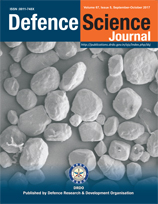Critical Analysis of Background Subtraction Techniques on Real GPR Data
DOI:
https://doi.org/10.14429/dsj.67.10048Keywords:
Ground penetrating radar, Singular value decomposition, Principal component analysis, Independent component analysis, Training method, SCR, Generalised inner product, Generalised likelihood ratioAbstract
Ground penetrating radar (GPR) is used to detect the underground buried objects for civil as well as defence applications under varying conditions of soil moisture content. The capability of detection depends upon soil moisture, target characteristics and subsurface characteristics, which are mainly responsible for contaminating the GPR images with clutter. Researchers earlier have used averaging, mean, median, Eigen values, etc. for subtracting the background from GPR images. To analyse the background subtraction or clutter reduction problems, in this paper, we have experimentally reviewed background subtraction techniques with or without target conditions to enhance the target detection under variable soil moisture content. Indigenously developed GPR has been used to collect the data for different soil conditions and several background subtraction signal processing techniques were critically reviewed like, mean, median, singular value decomposition (SVD), principal component analysis (PCA), independent component analysis (ICA) and training methods. The signal to clutter ratio (SCR) measurement has been used for performance evaluation of each technique. The relative merits and demerits of each technique has also been analysed. The background subtraction techniques have been appliedto experimental GPR data and it is observed that in comparison of mean, SVD, median, ICA, PCA, the training method shows the highest SCR with buried target. Finally, this review helps to select the comparatively better background subtraction technique to enhance the detection capability in GPR.
Downloads
Published
How to Cite
Issue
Section
License
 Where otherwise noted, the Articles on this site are licensed under Creative Commons License: CC Attribution-Noncommercial-No Derivative Works 2.5 India
Where otherwise noted, the Articles on this site are licensed under Creative Commons License: CC Attribution-Noncommercial-No Derivative Works 2.5 India


